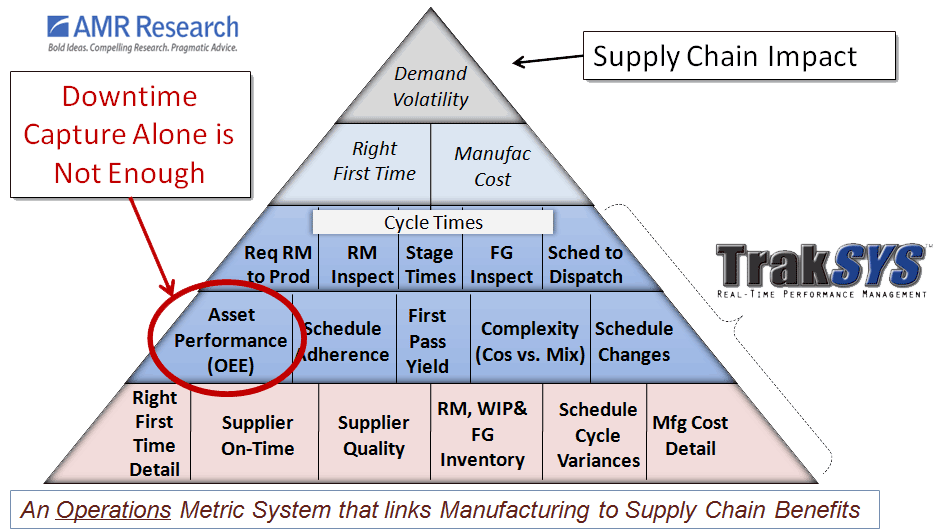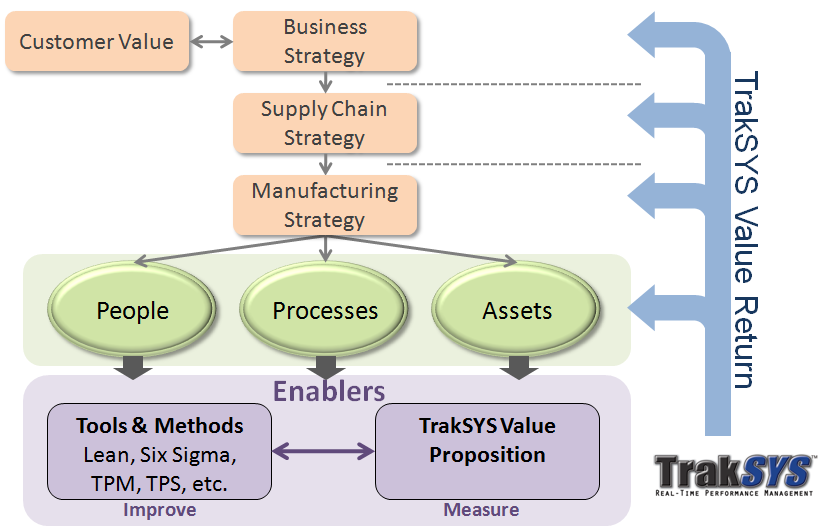Why Real-time Performance Management matters?
As a manufacturer, there is value in having real-time access to production information and metrics in order to support manufacturing improvement decisions. Real-time performance management solutions provide rapid, accurate access to metrics such as cycle time, yield, capacity, efficiency and downtime and also support root cause analysis, regulatory requirement, production and batch reporting. When making decisions that affect the future of your business it helps to have quality information at hand.
This said today many manufacturers still rely on a paper trail for information so does “Real-time Performance Management” matter?
Performance Improvement
What we know is that manufacturers today face, and will continue to face, the pressures of improving performance to increase shareholder value, competitive advantage and long-term sustainability. We also know that the customer will ultimately determine if the business succeeds and should be considered in all improvement initiatives.
An example of this may be the drive to decrease inventory levels throughout the plant. This requires careful balancing of minimal inventory levels while filling customer orders on time, correctly, and in perfect condition in order to create high levels of customer satisfaction while reducing inventory costs. Stock-outs due to low inventory could result in customers seeking alternate suppliers with major and long-term implications for the business.
Lean manufacturing is a continuous improvement program that has customer value as a focal point while striving to eliminate all non-value-added activities (effort, time, resources) in the production process. Some of the key drivers for manufacturers to engage in a Lean program are highlighted in the figure below from research done by the Aberdeen Group.

Three important requirements that are apparent in all these drivers is the need to improve quality, reduce cycle time (delivery) and reduce production costs. Costs are directly associated with the efficient use of equipment, raw materials and other resources in the production of goods for sale. Cycle time relates directly to product flow and inventory levels in the plant (See Little’s Law) and overall lead time influencing customer delivery.
Real-time Performance Management
As the name suggests RPM focuses on acquiring data as soon as it is available (Real-time). Here manufacturers can benefit by accessing data directly from programmable logic controllers (PLC) and automation software. In the case of manual data capture, this would mean getting the data as soon as possible directly from the entry source.
Performance can be defined as “The degree to which a system or component accomplishes its designated functions within given constraints”. This implies the use of metrics in measuring the level of performance achieved.
The result is accurate information that is relevant and can be used to successfully influence management decisions regarding changes that impacts manufacturing performance. Performance indicators provide the feedback required to measure the trend of improvements made and are important to understanding the scale of the business problem and the potential for improvement (See figure below).

Overall Equipment Effectiveness (OEE) is a Real-time Performance Management metric that trends the impact of the classical 6 big losses as defined by the Total Productive Management (TPM) improvement program. OEE is an equipment centric RPM metric that measures the quality, performance and availability of systems.
Using available live data, Real-time Performance Solutions are able to accurately capture the duration of idle and minor downtime to expose the true cost of this hidden loss. Details regarding equipment events also provide a rich set of information for root cause analysis of performance losses.
Other metrics may include Adherence to Schedule, yields, energy efficiency, value stream performance, production targets, raw material waiting time and cycle time. Many companies also have a number of metrics that measure performance aspects unique to their industry.
Operations Metrics and Supply Chain benefits
AMR Research has developed an “Operations Metric Hierarchy” that shows how the manufacturer’s ability to meet fluctuations in product demand is based on a number of operational factors. Unlike customer demand which can vary and is often an estimation, the manufacturer has full control over these metrics which in turn impact significantly on the supply chain and the ability to deliver products on time, right the first time and at a competitive cost while maximising profits.
As the figure below indicates the typical equipment focus (OEE) of most downtime monitoring solutions is not enough. There are many other factors other than OEE that must be included for a complete picture of performance. For example, if schedules are not adhered to, the resulting stock outs (raw material) can result in a significant loss of productive time impacting on cycle time and costs and ultimately the ability to satisfy customer demand.

A Real-time Performance Management solution makes use of production information to capture the date and time of events and their duration in order to determine the variance from the plan and the actual cycle times while manufacturing multiple different products on the same equipment.
This information is captured in the context of equipment, product, time, process, people and other parameters that influence performance. This provides users with the information needed for root cause analysis and a deeper understanding of the problem.
Continuous Improvement benefits from RPM
Continuous improvement programs such as Lean manufacturing, TPM and Six Sigma (and variations of these) are vital in involving production staff in the quest for maximum performance. These programs highlight the impact of waste and variance on the business and enable production staff to reduce losses resulting in reduced cycle times and manufacturing costs.
Some of the challenges these teams face however are:
- Lack of timely information and visibility across the plant floor
- Lack of detailed information for root cause analysis
- Understanding the true impact of idle time and minor stops (difficult to measure)
- Gathering information and generating production performance metrics
- Providing a holistic view of production performance including yields, equipment utilisation, schedule adherence, the impact of product change, energy utilisation, the impact of people and processes to enable focus on the right issues
- Accurate and punctual capture of production log sheets
Plants suffering from poor yields, excess work in process, and long cycle times often see dramatic improvements from these practical improvement techniques. However, over time they find that manual methods are labour intensive and do not scale across the factory. In order to reduce the number of manual steps, factory staff typically develop spreadsheet tools specific to their production lines or product families. Rarely is there any standardization among these specific tools and drawbacks to these tools include: limited reuse of best practices, inability to scale across the factory, and heavy reliance on “tribal knowledge” within the plant.

A Real-time Performance Management solution such as TrakSYS from Parsec addresses these needs and enables these teams to unlock hidden value by providing information that carets clarity and visibility across the often complex manufacturing environment. When enabled with RPM information continuous improvement initiatives repeatedly deliver higher value and are more sustainable.
Final Thoughts
Although information and metrics can assist decisions and provide direction it is not enough on its own and should not be blindly followed. Dr Edwards Deming, credited with improving production in the United States during World War II, stated “many important factors are unknown and unknowable”, there is no substitute for knowledge.
Real-time Performance Management (RPM) solutions such as TrakSYS can be easily implemented without production disruption and help manufacturers to:
- Significantly improve asset utilization and efficiency
- Increase capacity with no new capital equipment
- Reduce production costs
- Improve product flow
- Improve profitability
- With measurable ROI and rapid payback (6 months), TrakSYS™ fuels Lean, Six Sigma, TPM, and Operational Excellence efforts.




